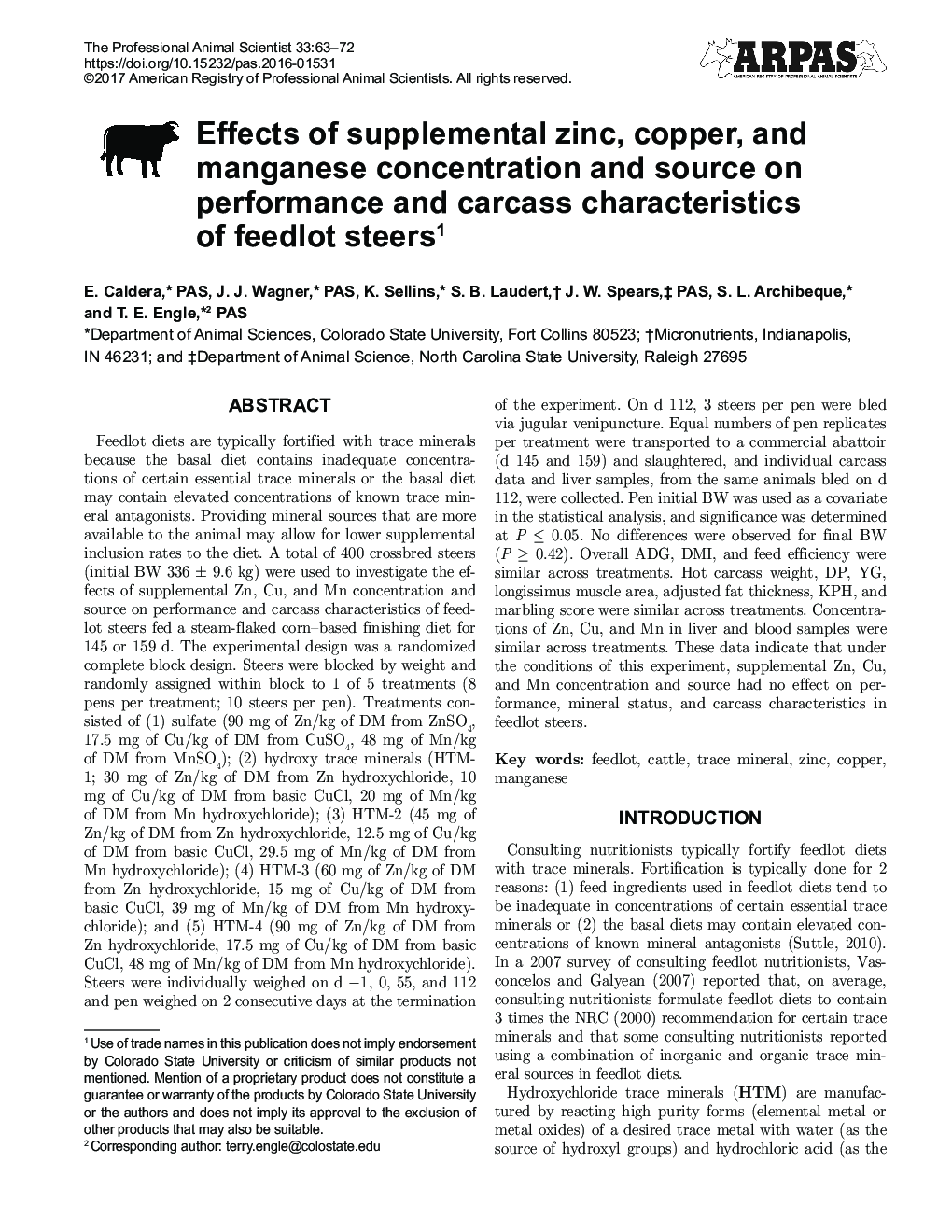| کد مقاله | کد نشریه | سال انتشار | مقاله انگلیسی | نسخه تمام متن |
|---|---|---|---|---|
| 8503784 | 1554284 | 2017 | 10 صفحه PDF | دانلود رایگان |
عنوان انگلیسی مقاله ISI
Effects of supplemental zinc, copper, and manganese concentration and source on performance and carcass characteristics of feedlot steers1
ترجمه فارسی عنوان
اثر متقابل غلظت روی، مس و منگنز و منبع بر عملکرد و خصوصیات لاشه مورچه های خوراکی 1
دانلود مقاله + سفارش ترجمه
دانلود مقاله ISI انگلیسی
رایگان برای ایرانیان
کلمات کلیدی
موضوعات مرتبط
علوم زیستی و بیوفناوری
علوم کشاورزی و بیولوژیک
علوم دامی و جانورشناسی
چکیده انگلیسی
Feedlot diets are typically fortified with trace minerals because the basal diet contains inadequate concentrations of certain essential trace minerals or the basal diet may contain elevated concentrations of known trace mineral antagonists. Providing mineral sources that are more available to the animal may allow for lower supplemental inclusion rates to the diet. A total of 400 crossbred steers (initial BW 336 ± 9.6 kg) were used to investigate the effects of supplemental Zn, Cu, and Mn concentration and source on performance and carcass characteristics of feedlot steers fed a steam-flaked corn-based finishing diet for 145 or 159 d. The experimental design was a randomized complete block design. Steers were blocked by weight and randomly assigned within block to 1 of 5 treatments (8 pens per treatment; 10 steers per pen). Treatments consisted of (1) sulfate (90 mg of Zn/kg of DM from ZnSO4, 17.5 mg of Cu/kg of DM from CuSO4, 48 mg of Mn/kg of DM from MnSO4); (2) hydroxy trace minerals (HTM-1; 30 mg of Zn/kg of DM from Zn hydroxychloride, 10 mg of Cu/kg of DM from basic CuCl, 20 mg of Mn/kg of DM from Mn hydroxychloride); (3) HTM-2 (45 mg of Zn/kg of DM from Zn hydroxychloride, 12.5 mg of Cu/kg of DM from basic CuCl, 29.5 mg of Mn/kg of DM from Mn hydroxychloride); (4) HTM-3 (60 mg of Zn/kg of DM from Zn hydroxychloride, 15 mg of Cu/kg of DM from basic CuCl, 39 mg of Mn/kg of DM from Mn hydroxychloride); and (5) HTM-4 (90 mg of Zn/kg of DM from Zn hydroxychloride, 17.5 mg of Cu/kg of DM from basic CuCl, 48 mg of Mn/kg of DM from Mn hydroxychloride). Steers were individually weighed on d â1, 0, 55, and 112 and pen weighed on 2 consecutive days at the termination of the experiment. On d 112, 3 steers per pen were bled via jugular venipuncture. Equal numbers of pen replicates per treatment were transported to a commercial abattoir (d 145 and 159) and slaughtered, and individual carcass data and liver samples, from the same animals bled on d 112, were collected. Pen initial BW was used as a covariate in the statistical analysis, and significance was determined at P ⤠0.05. No differences were observed for final BW (P ⥠0.42). Overall ADG, DMI, and feed efficiency were similar across treatments. Hot carcass weight, DP, YG, longissimus muscle area, adjusted fat thickness, KPH, and marbling score were similar across treatments. Concentrations of Zn, Cu, and Mn in liver and blood samples were similar across treatments. These data indicate that under the conditions of this experiment, supplemental Zn, Cu, and Mn concentration and source had no effect on performance, mineral status, and carcass characteristics in feedlot steers.
ناشر
Database: Elsevier - ScienceDirect (ساینس دایرکت)
Journal: The Professional Animal Scientist - Volume 33, Issue 1, February 2017, Pages 63-72
Journal: The Professional Animal Scientist - Volume 33, Issue 1, February 2017, Pages 63-72
نویسندگان
E. PAS, J.J. PAS, K. Sellins, S.B. Laudert, J.W. PAS, S.L. Archibeque, T.E. PAS,
